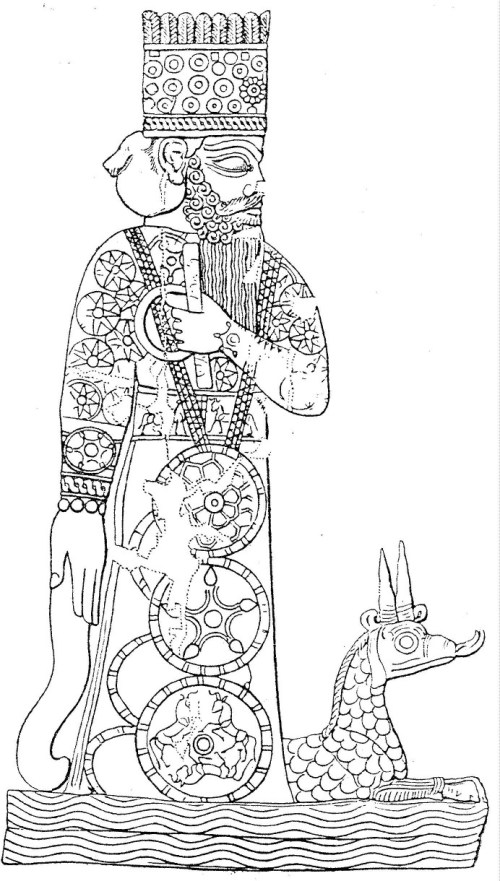Ibn Wahshiyya and Black Magic
“Magic has a prominent role in the Nabatean corpus, especially in Filāha and Sumūm. Following the theme of the present conference, I would like to make some comments on the relation of Ibn Wahshiyya to magic.
First of all, it should be clear that there was no ban against such material in the early tenth century. Magic, and especially its practice, was not perhaps looked on benevolently by Ihe ‘ulamā’, but in the Shiite Iraq governed by the Būyids there was not much possibility for the Sunni ‘ulamā’ to react against those interested in magic, occult sciences and esoterica.
On the other hand, the open paganism and polytheism of much of Ihe material in Filāha and the other Nabatean books would make it necessary for the author to keep his distance from the material. In Ibn Wahshiyyas’ case this presented no great problem, since he purported only to translate, not to compose the material, and the open paganism of the text could always be labelled as merely vestiges of ancient paganism.
In fact, the translator often adds clearly and strongly monotheistic notes to the text (see esp. Filāha, pp. 405-406), thus safeguarding himself from any accusations of an over close identification with the polytheistic, Nabatean system.
Ibn Wahshiyya is also very careful, especially in Filāha, to keep his distance from black magic. In his toxicological work Sumūm, a more controversial book by its very nature, he is not so prudent. He also often refuses to speak of harmful uses of a plant (e.g. Filāha, p. 184, II. 6-7) and apologizes for speaking about poisons in Sumūm, fol. 5a. This recurrent motif shows that Ibn Wahshiyya was aware of the negative response his works might attract.
For Ibn Wahshiyya, magic is a real operative force in the universe. His world view is, generally speaking, Neoplatonic, and the cult he is describing is astral, which brings with it the idea of a correspondence between macrocosm and microcosm as well as other correspondences between different phenomena.
The thoroughly magical worldview of Ibn Wahshiyya is seen in the strong magical element in Filāha, a work dealing with agriculture. In this, Filāha resembles, and has perhaps been influenced by, similar Greek works, especially the book of Bōlos Dēmokritos, where magic, agriculture and folklore are found side by side—On the other hand, one should not forget the sober and often experimental attitude of Ibn Wahshiyya towards agriculture in general: he is not an obscurantist trading with talismans and amulets, but a learned and perspicacious observer.
The Nabatean books make a clear difference between black and white magic; the former harmed people, the latter protected them. In Filāha, lbn Wahshiyya constantly avoids black magic (see e.g. pp. 383-384), although he does refer, in the words of the purported authors of the Aramaic original, to passages in the original sources which belonged to black magic (e.g. p. 477, by Sughrīth). The same prudence may also be seen in his other texts, although he does give some examples of black magic, especially in Sumūm.
In Filāha, the supposed Aramaic author claims ignorance of magic (p. 147: wa- ‘ilmu s-sihri ‘ilmun lam a ‘rid lahu wa-lā uhibbu an atakallama bimā lā ‘ilma lī bihi). In Sumūm, black magic is somewhat more prominent. Some of the poisons described in the work belong to the sphere of black magic more than to toxicology. One of these magical operations is the grotesque recipe for creating an animal, whose sight kills. Much abbreviated the recipe goes as follows:
One takes a young, monocoloured cow, sprinkles it with human blood, has sexual intercourse with it and inserts a special dough into its vagina. Finally one anoints its vagina with ox blood. The cow is kept in a dark stall and fed with a spec¡al diet. When it gives birth, the born monster, which is described in detail, is sprinkled with another powder. Seven days after its birth, it is ready to kill by sight when it smells a wad of cotton soaked with wine and becomes upset.
The creation of a calf, although in not so colourful a fashion, is well known from early Jewish mysticism. In Filāha, p. 1318, there is also a mention of ‘Ankabūthā, the chief magician, creating an anthropoid which reminds one of the Golem tradition in Kabbalistic literature.”
Jaakko Hāmeem-Anttila, “Ibn Wahshiyya and Magic,” Anaquel de Estudios Árabes X, 1999, pp. 43-4.

